10 Sump Pump Problems Reasons and How to Fix them

Improper sump pump operations can cause sump pump problems. Sump pump problems can prevent the water removal process from the basement or crawlspace. It may cause severe water damage in the home, including basement flooding, mold and mildew growth, higher humidity, efflorescence, material degradation and deterioration, wood warping and rotting, stain marks, and paint peeling. In order to prevent this, you should identify the sump pump problems are address them as soon as possible you can.
So here are 11 sump pump problems you should pay attention to mostly.
- Sump Pump Power Failure
- Clogged Sump Pump Discharge Pipe
- Frozen Discharge Pipe
- Stuck or Faulty Sump Pump Float Switch
- Sump Pump is Continuously Running
- Sump Pump Not Turning On
- Overwhelmed the Sump Pump
- Sump Pump Backflow
- Sump Pump Humming But Not Pumping
- Sump Pump Motor Burnout
When you observe these problems, you can fix them by following these methods. As well as you can also reset the submersible sump pump. If there is a severe problem, you should replace and install a new one for the best solution.
This guide is prepared according to the Aqviz experts’ experience, and we have included the most suitable reasons and the easiest way to fix it within a limited period.
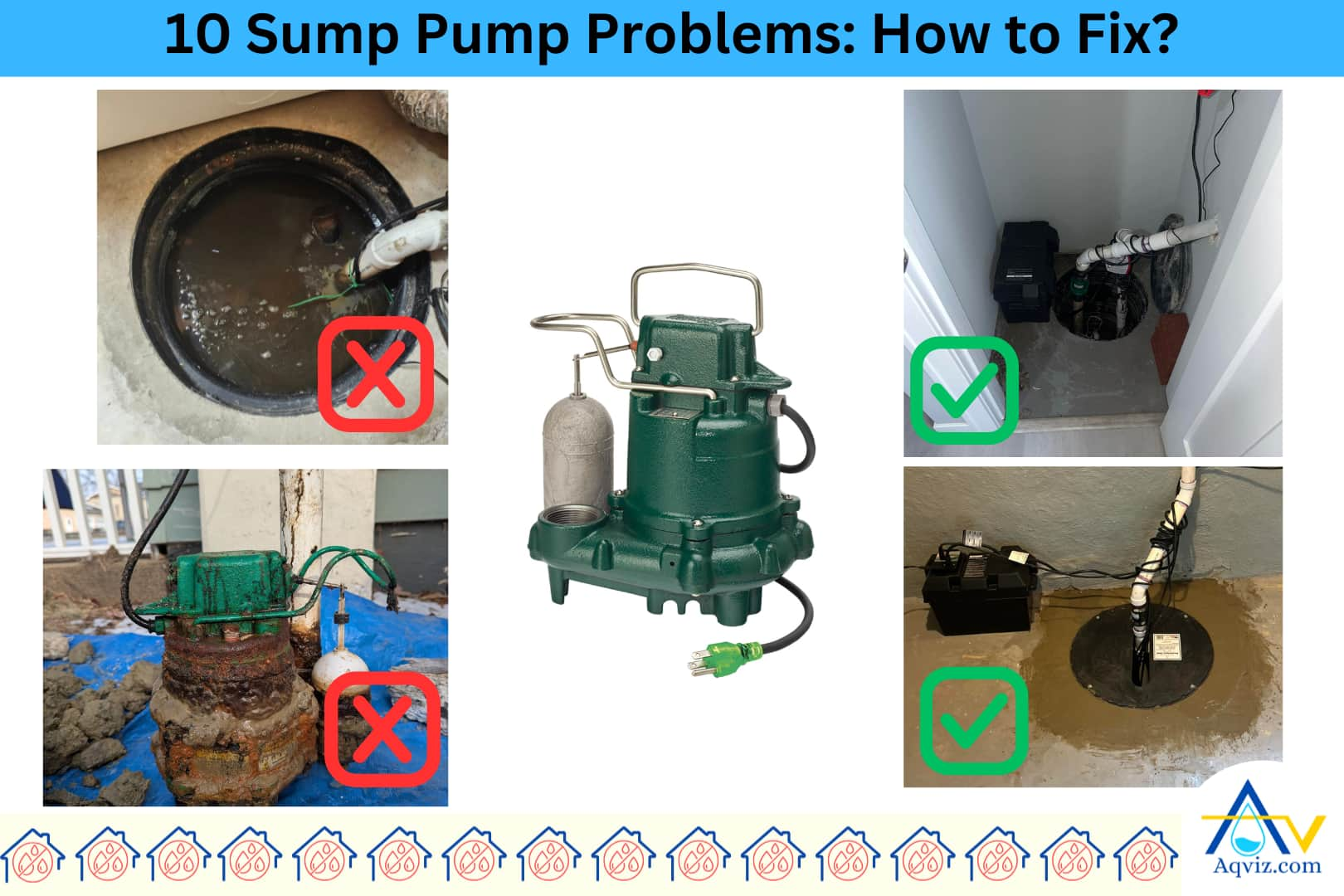
1. Sump Pump Power Failure
Sump pump power failure is the loss of electrical power that prevents the sump pump from activating and removing water from the sump pit. This failure stops the pump from running when groundwater rises, leaving the basin to overflow and potentially flood the basement or crawlspace.
Sump pump failure occurs due to these 6 reasons such as
- The main power supply is interrupted due to storms, tripped breakers, or blown fuses.
- The GFCI outlet trips, cutting power to the sump pump.
- The sump pump power cord is damaged or unplugged.
- The pump’s internal wiring is corroded or burned out.
- Improper voltage supply to the sump pump causes electrical failure or erratic operation.
- The battery backup sump pump system fails due to a dead battery or a faulty inverter.
How to fix Sump Pump Power failure?
- Reset the sump pump GFCI outlet or circuit breaker and test the power line.
- Inspect the sump pump power cord for damage or loose connections.
- Use a multimeter to check the voltage of the sump pump at the outlet.
- Replace sump pump worn batteries or faulty backup inverters.
- Install a generator or battery backup system for future outages.
Read More About: 6 Signs of Sump Pump Failures: Reasons and What to Do?
2. Clogged Sump Pump Discharge Pipe
A clogged sump pump discharge pipe is a common problem where blockage inside the outlet pipe prevents the sump pump from removing water efficiently. When the discharge line is blocked, the sump pump continues to run without pushing water out, leading to pressure buildup, short cycling, and potential pump burnout.
Clogged sump pump discharge pipe occurs due to these 5 reasons such as
- Sump pump discharge lines collect debris, silt, or sediment over time
- Ice blockage forms inside the sump pump outlet pipe during freezing weather
- Tree roots or soil intrude into buried sump pump discharge pipes
- Poor slope in the sump pump drain line causes stagnant water and clog formation
- Open discharge ends allow animals or dirt to enter the sump pump piping system
How to fix clogged sump pump discharge pipe?
- Disconnect and flush the sump pump discharge pipe with a garden hose or plumber’s snake
- Insulate or heat-tape the sump pump’s outdoor piping to prevent winter freeze-ups
- Install a screened or grated cover on the end of the sump pump outlet to block debris
- Adjust the sump pump discharge pipe angle to maintain proper drainage slope
- Regularly inspect and clean the sump pump discharge system to ensure steady water flow
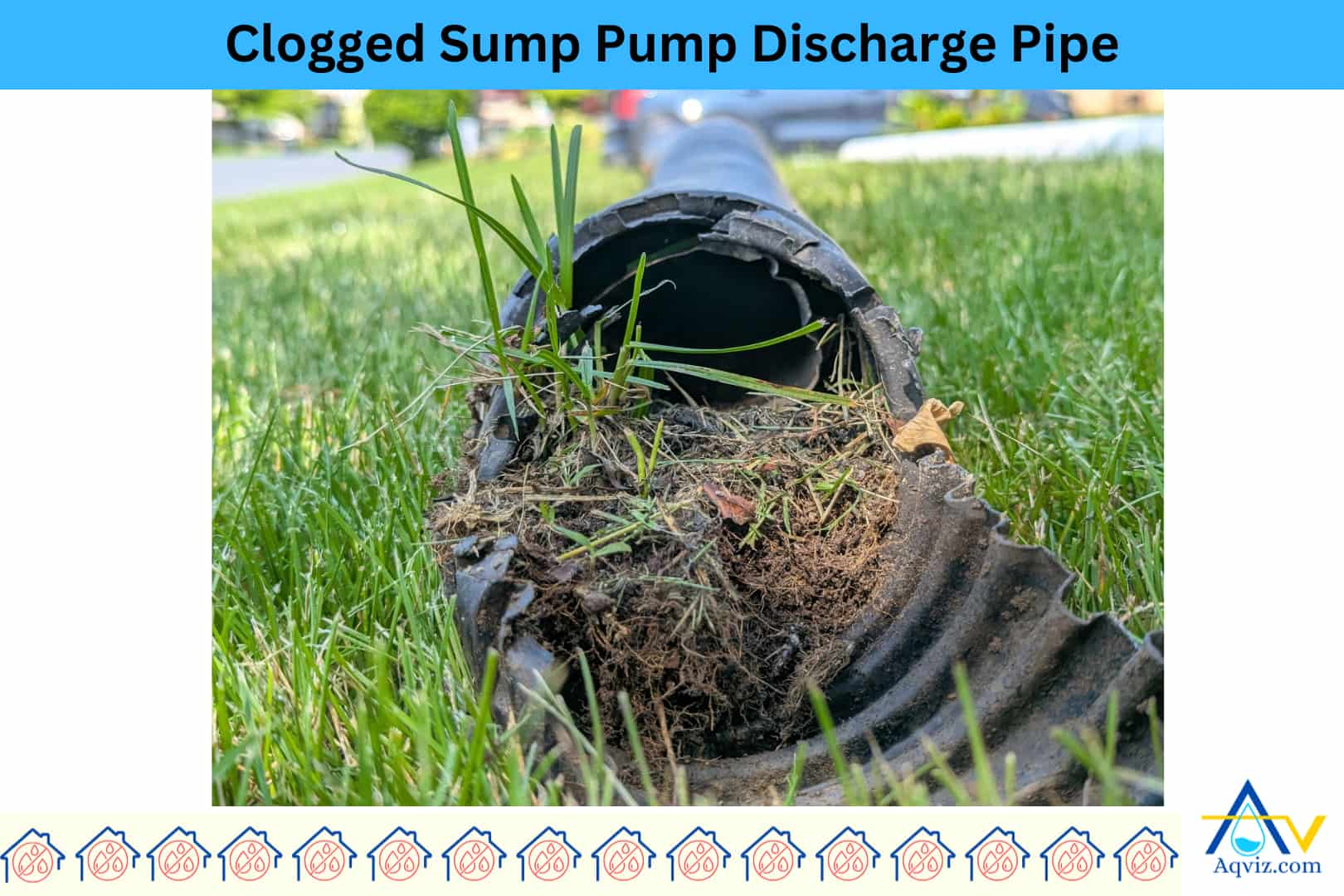
3. Frozen Discharge Pipe
A frozen sump pump discharge pipe occurs when cold temperatures cause standing water inside the discharge line to freeze, blocking the sump pump from expelling water. When the discharge pipe freezes, the sump pump runs but cannot move water, which leads to pressure buildup, motor strain, and possible basement flooding.
Frozen sump pump discharge pipe occurs due to these 4 reasons such as
- The sump pump discharge line is exposed to freezing outdoor air without insulation
- Standing water remains inside the sump pump outlet pipe due to poor slope or improper drainage
- The discharge pipe is buried too shallow, allowing frost penetration near the sump pump system
- Lack of a check valve causes water to backflow and freeze inside the sump pump piping
How to fix fix the frozen sump pump discharge pipe?
- Insulate or heat-tape the sump pump discharge pipe to prevent ice formation
- Bury the sump pump outlet line at least 12 inches (30 cm) below the frost line
- Install a check valve to stop water from flowing back into the sump pump line
- Ensure the sump pump drain pipe has a proper slope to prevent standing water
- Use a discharge extension with a freeze-resistant design for the sump pump system
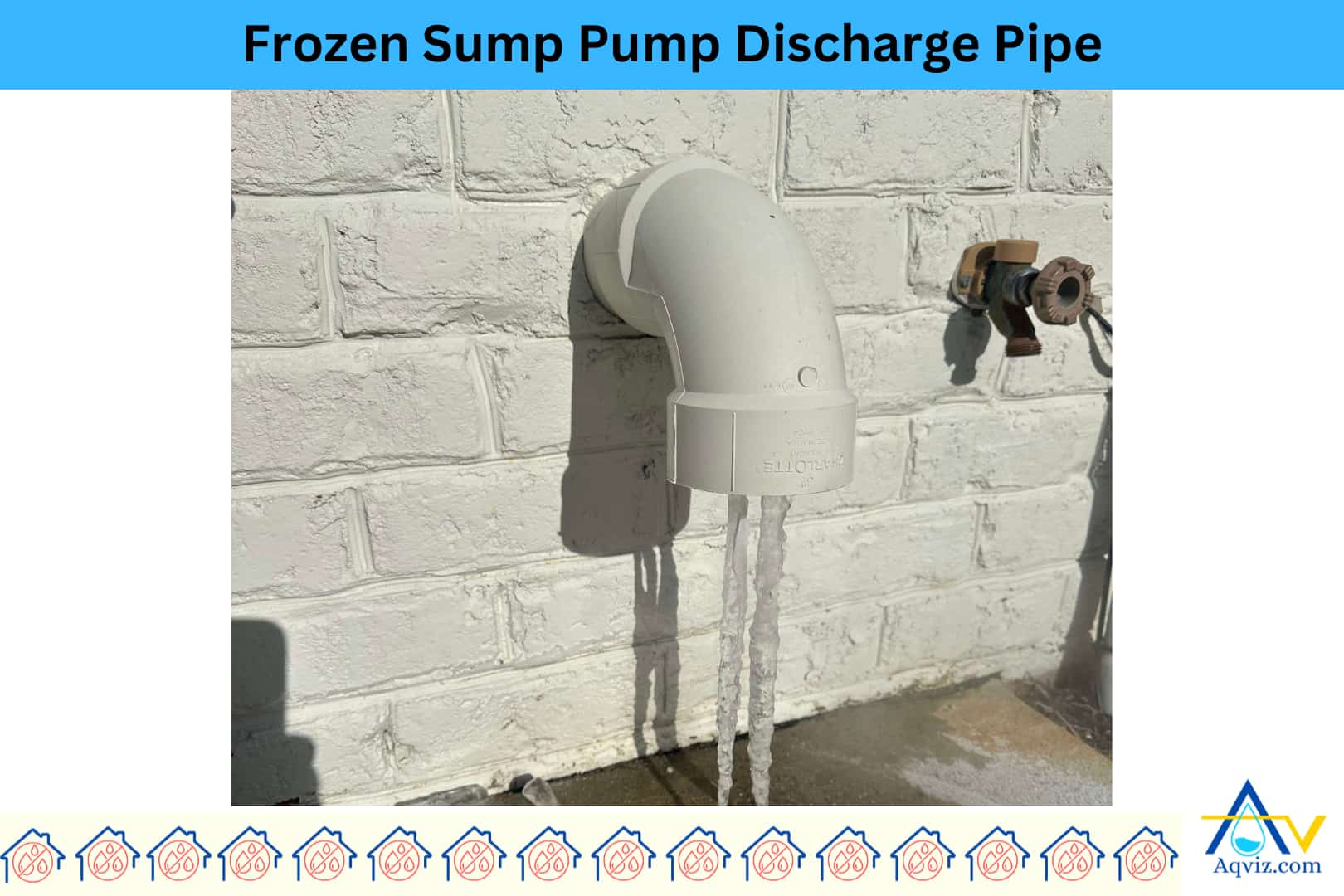
4. Stuck or Faulty Sump Pump Float Switch
A stuck or faulty sump pump float switch prevents the sump pump from turning on or off at the correct water level, leading to either continuous running or complete failure to activate. Since the float switch controls the pump’s operation, any malfunction leaves the sump pump system unreliable during heavy water inflow.
Stuck or faulty sump pump float switch occurs due to these reasons such as
- The sump pump float gets obstructed by debris, the basin wall, or tangled cords
- Poor placement causes the sump pump float switch to snag against the pump housing
- The sump pump switch mechanism wears out over time and fails to trigger
- Improper basin size doesn’t allow free movement of the sump pump float arm
- Waterlogging or internal damage affects the buoyancy of the sump pump float
How to fix the stuck or faulty sump pump float switch?
- Clear debris and reposition cords around the sump pump float for free movement
- Adjust the sump pump or float location within the basin to prevent sticking
- Replace the sump pump float switch if it’s damaged or worn
- Upgrade to a vertical float or electronic sensor for better sump pump control
- Ensure the sump pump basin is large enough for unrestricted float operation
5. Sump Pump Is Continuously Running
A sump pump that is continuously running indicates a malfunction that causes the pump to stay on even when water levels are low or stable. When the sump pump runs nonstop, it leads to motor overheating, premature wear, and higher energy consumption, eventually reducing the pump’s lifespan.
Sump pump continuously running occurs due to these 5 reasons such as
- A stuck float switch keeps the sump pump activated even when the pit is empty
- The sump pump check valve is missing or broken, causing water to flow back into the pit
- A high water table constantly fills the pit, forcing the sump pump to work nonstop
- An undersized sump pump struggles to keep up with water inflow, running constantly
- The sump pump discharge line is clogged or restricted, slowing down water removal
How to fix fix the continuously running sump pump?
- Inspect and free up the sump pump float switch for smooth operation
- Install or replace the sump pump check valve to prevent backflow
- Upgrade to a larger capacity sump pump suited for your water volume
- Clear any blockages in the sump pump discharge pipe
- Evaluate the sump pump pit for proper size and adjust float settings accordingly
6. Sump Pump is Not Turning On
A sump pump not turning on is a critical issue where the pump fails to activate when the water level rises, leaving the sump pit to overflow and increasing the risk of basement flooding. When the sump pump does not start, it compromises the entire drainage system during storms or plumbing leaks.
Sump pump not turning on occurs due to these 5 reasons such as
- The sump pump power supply is disconnected, tripped, or interrupted
- A faulty float switch fails to signal the pump to start
- The sump pump motor is burned out or seized from wear or overheating
- Internal wiring damage inside the sump pump housing causes electrical failure
- Debris in the sump basin jams the pump or float mechanism, blocking operation
How to fix the sump pump not turning on?
- Check and reset the sump pump power source or GFCI outlet
- Inspect and test the sump pump float switch for free movement and response
- Clear out the sump pump basin to remove any blockages or obstructions
- Use a multimeter to test for power and diagnose sump pump motor failure
- Replace the sump pump unit if the motor is unresponsive or beyond repair
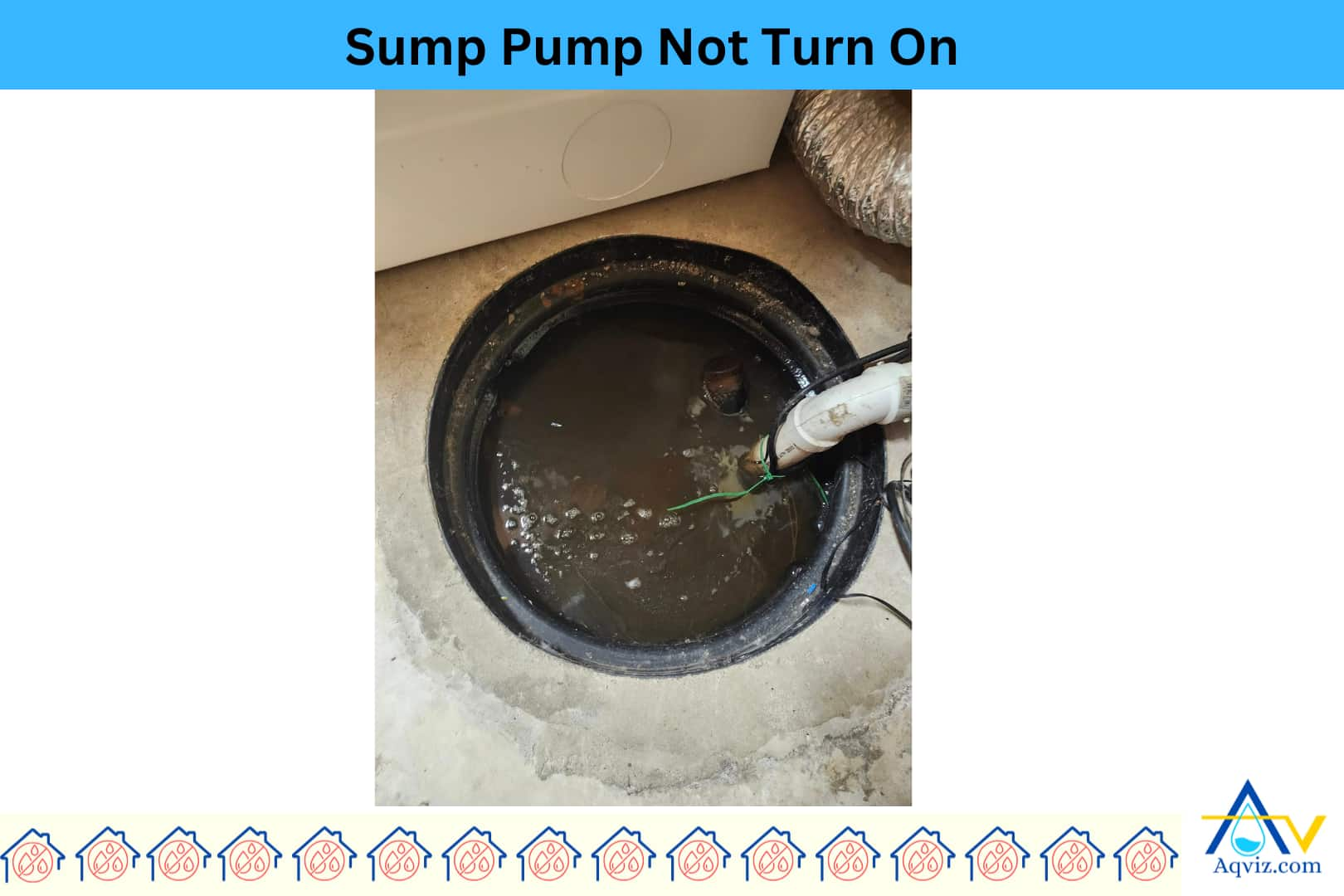
7. Overwhelmed Sump Pump
An overwhelmed sump pump occurs when the pump cannot keep up with the volume of incoming water, causing the sump pit to overflow. When the sump pump is overwhelmed, it leads to basement flooding, water damage, and excessive wear on the pump’s motor and components.
An overwhelmed sump pump occurs due to these 5 reasons such as
- The sump pump capacity (GPH) is too low for the water inflow during storms
- A high water table or poor drainage causes constant water accumulation
- The sump pump discharge line is too long, narrow, or elevated, restricting flow
- Multiple water sources like foundation drains and appliance drain into the sump pit
- The sump pump system lacks a secondary or battery backup pump for high-demand situations
How to fix an overwhelmed sump pump?
- Upgrade to a higher horsepower sump pump with greater pumping capacity
- Add a second sump pump or install a battery backup system
- Improve yard grading and install French drains to divert surface water
- Widen or shorten the sump pump discharge line to reduce flow restriction
- Reduce the number of systems draining into the sump pump basin if possible
8. Sump Pump Backflow
Sump pump backflow is when discharged water flows back into the sump pit instead of exiting the system, forcing the sump pump to reprocess the same water. This issue increases pump cycles, causes premature motor wear, and reduces the system’s overall efficiency.
Sump pump backflow occurs due to these 5 reasons such as
- A missing or faulty check valve allows water to return after the pump shuts off
- The check valve is installed backward or improperly sealed
- The discharge pipe slope is incorrect, causing standing water to reverse into the pit
- The sump pump discharge line ends in a low area, creating reverse flow pressure
- Water hammer effects from a sudden stoppage force water back toward the sump pit
How to fix the sump pump backflow?
- Install a properly rated check valve above the sump pump discharge port
- Ensure the check valve is installed in the correct flow direction
- Adjust the discharge pipe angle to maintain a continuous outward slope
- Extend the sump pump outlet pipe to a higher or better-drained location
- Replace damaged or leaking sump pump check valves promptly
9. Sump Pump Humming But Not Pumping
Sump pump humming but not pumping is a condition where the sump pump motor produces a humming sound, but no water is being discharged. This indicates that the sump pump is receiving power but is unable to move water due to internal blockage, mechanical failure, or motor obstruction.
Sump pump humming but not pumping occurs due to these 5 reasons such as
- A jammed impeller prevents the sump pump from rotating and moving water
- The check valve is stuck closed, blocking water flow from the sump pump outlet
- Airlock in the discharge pipe stops water from passing through
- The sump pump motor shaft is damaged or seized internally
- The intake screen or pump housing is clogged with debris
How to fix the sump pump humming but not pumping?
- Unplug the sump pump, remove debris, and inspect the impeller for blockages
- Tap the check valve gently to release it or replace it if faulty
- Drill a weep hole in the discharge pipe to relieve the airlock
- Inspect the motor shaft and bearings for damage or wear
- Clean the sump pump intake screen and ensure clear water flow paths
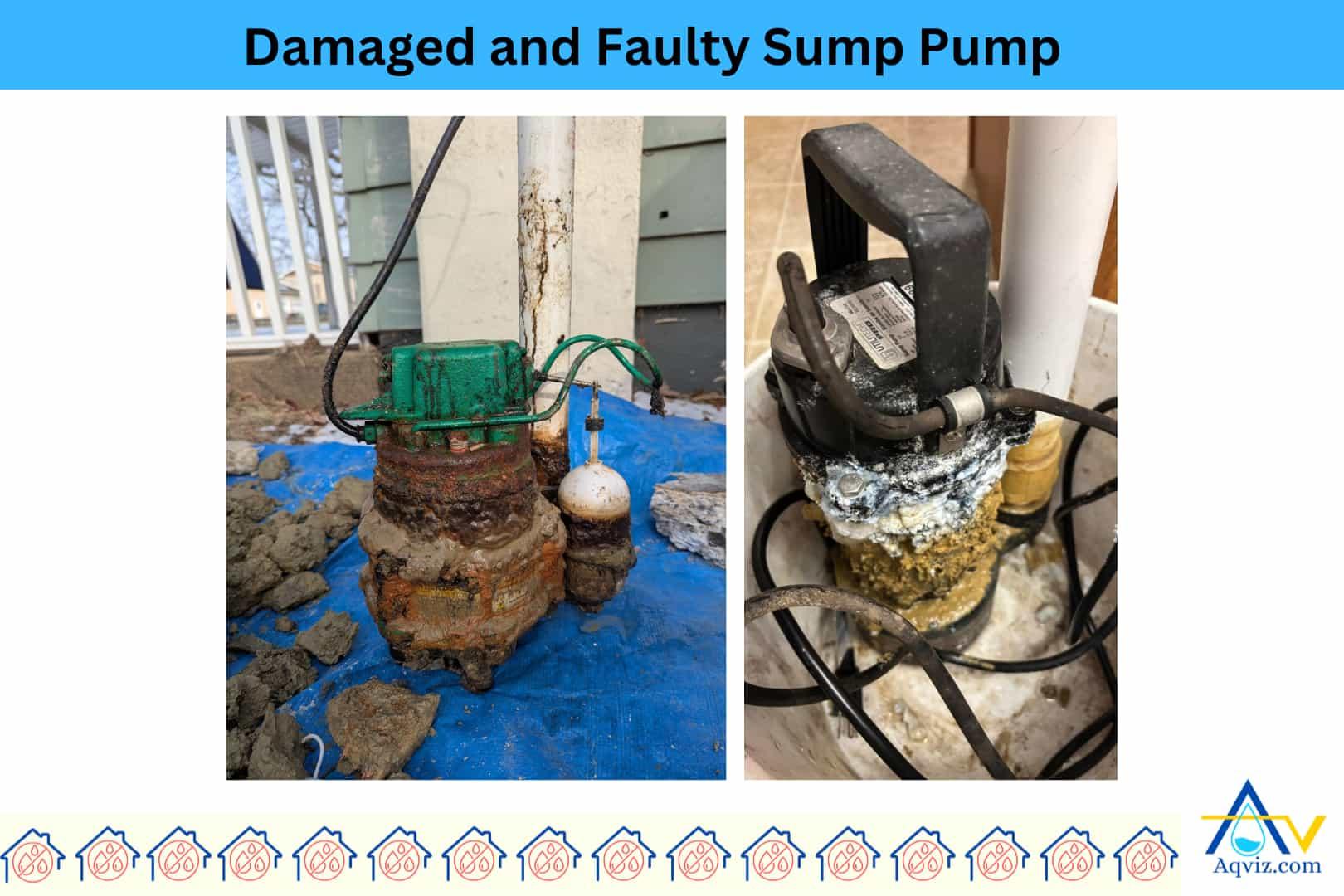
10. Sump Pump Motor Burnout
Sump pump motor burnout is a serious failure where the pump’s motor overheats and permanently stops working, leaving the sump pump unable to remove water from the pit. When the sump pump motor burns out, it often results in unexpected flooding, especially during storms or peak water inflow.
Sump pump motor burnout occurs due to these 5 reasons such as
- The sump pump runs continuously due to a stuck float or constant water inflow
- The pump is undersized, causing overexertion and overheating
- Blocked discharge lines make the sump pump motor work harder under pressure
- Dry running occurs when the sump pump operates without enough water for cooling
- Poor electrical supply or voltage fluctuations damage the sump pump motor winding
How to fix the sump pump motor burnout?
- Replace the burned-out sump pump with a properly sized and rated model
- Clear the discharge pipe to reduce backpressure on the pump
- Install a secondary or backup sump pump to share the load
- Use a pump with thermal overload protection to shut off during overheating
- Ensure the sump pit always has sufficient water before the pump activates
How to Reset a Submersible Sump Pump?
Resetting a submersible sump pump is a quick way to restore its operation after a power interruption, float switch malfunction, or tripped outlet. A proper reset helps clear minor faults and gets the sump pump running again without needing full disassembly.
You can reset a submersible sump pump by following these 5 steps
- Unplug the sump pump from the GFCI outlet and wait for 10-15 seconds
- Inspect the float switch for any obstructions or debris that may cause it to stick
- Plug the sump pump back in securely and ensure the power source is active
- Manually lift the float to check if the sump pump activates
- If the sump pump does not respond, press the reset button (if your model has one) or test the GFCI outlet for faults
How to Install a Sump Pump?
10 steps to install a sump pump
- Gather relevant tools and materials for sump pump installation
- Identify the lowest point for sump pump installation
- Mark and dig the sump pit
- Install the sump basin (liner)
- Backfill around the sump basin
- Place the sump pump
- Connect the sump pump discharge pipe
- Route sump pump discharge pipe out of the home
- Seal and restore the floor
- Test and power the sump pump system
Read More About: How to Install a Sump Pump?
